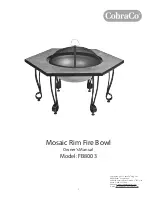
25
TEMPERATURE ADJUSTMENT
APPROXIMATE TIME/TEMPERATURE RELATIONSHIPS IN SCALDS
120°F
(49°C)
More than 5 minutes
125°F
(52°C)
1½ to 2 minutes
130°F
(54°C)
About 30 seconds
135°F
(57°C)
About 10 seconds
140°F
(60°C)
Less than 5 seconds
145°F
(63°C)
Less than 3 seconds
150°F
(66°C)
About 1½ seconds
155°F
(68°C)
About 1 second
The temperature selector knob of the thermostat has been adjusted to its lowest setting when shipped from the factory.
The marking on the thermostat temperature scale (shown at left) is the preferred starting point
for setting the temperature control. For energy-efficient operation of your water heater, the
suggested initial temperature setting is approximately 120°F
(49°C).
Households with small
children or invalids may require a 120°F
(49°C)
or lower temperature setting to reduce the risk
of scald injury. Some states require a lower temperature setting. Full counterclockwise
rotation of the temperature selector dial is the minimum temperature setting. Full clockwise
rotation of the temperature selector dial is the maximum temperature setting. NOTE:
The lower the temperature setting, the greater the energy efficiency, both to heat the water and
to maintain its temperature during standby periods. Lower water temperatures also extend
tank life. Remember, no water heating system will provide exact temperatures at all times.
Allow a few days of operation at this setting to determine the correct temperature setting
This water heater, when set at a lower temperature setting, is not capable of producing hot water of sufficient
temperature for sanitizing purposes.
CAUTION
Whenever the water heater is filled with cold water, condensate will form on the cool tank surface and drops of water
will fall on the hot burner and combustion chamber surfaces producing a “sizzling” noise. Condensation is normal
and does not indicate a leak. It will disappear when the tank becomes heated.
The lower the temperature setting, the greater the energy efficiency, both to heat the water and to maintain the
storage temperature during standby periods. Lower water temperatures also extend tank life. Remember, no water
heating system will provide exact temperatures at all times. Allow a few days of operation at this setting to
determine the correct temperature setting consistent with the requirements for the installation.
Condensation does not mean your tank is leaking. Over 40% of reported tank leaks on installation are proven to be
condensation. To avoid unnecessary expense and inconvenience, make sure the tank is leaking before calling a
service person.
NOTICE
Hotter water increases the risk of scald injury. Scalding may occur within five (5) seconds at a temperature setting
of 140
F
(60
C)
. To protect against hot water injury, install an ASSE approved mixing valve in the water system.
This valve will reduce point of discharge temperature by mixing cold and hot water in branch water lines. A licensed
plumbing professional or local plumbing authority should be consulted.
This water heater is equipped with an energy cut out device to prevent overheating. Should overheating occur or
the gas supply fail to shut off, turn off the manual gas control valve to the appliance and call a qualified service
technician.
DANGER
















































